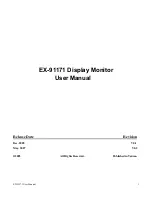
English-10
AUTO FINE (Analog input only)
This function automatically and periodically adjusts the “FINE” setting for change in signal condition.
This function adjusts approximately every 33 minutes.
EXPANSION
Sets the zoom method.
FULL:
The image is expanded to the MDview model’s native mode, regardless of the resolution.
ASPECT:
The image is expanded without changing the aspect ratio.
OFF:
The image is not expanded.
CUSTOM:
Refer to the ADVANCED OSD Controls menu section of the user’s manual for detailed instructions.
Color Control Systems
Colour Control Systems:
Seven preset colour settings.
For preset settings 1, 2, 3, and 5, the following levels can be adjusted:
TEMPERATURE:
Adjust the white temperature by increasing or decreasing this setting. A lower colour temperature
will make the screen reddish and a higher colour temperature will make the screen bluish.
WHITE (White Balance)
: If TEMPERATURE needs further adjustment, the individual R/ G/ B/ levels of the white
point can be adjusted. To adjust the R/G/B levels, CUSTOM must be showing as the TEMPERATURE selection.
HUE:
Adjusts the hue of each colour*
1
. The change in colour will appear on screen and the menu colour bars will
show the amount of adjustment.
SATURATION:
Adjusts the colour depth of each colour*
1
. Press the “RIGHT” button and the colour vividness
increases.
OFFSET:
Adjusts the colour brightness of each colour*
1
. Press “RIGHT” button and the colour Brightness increases.
*1: RED, YELLOW, GREEN, CYAN, BLUE and MAGENTA.
NATIVE, sRGB:
Original colour presented by the LCD panel that is unadjustable.
PROGRAMMABLE:
The colour tone that was set up with the downloaded application software is reflected.
NOTE:
To reset a poor image setting, turn on the monitor by using front power button while holding “RESET” and
“SELECT” buttons at the same time.
Tools
SHARPNESS
This function is digitally capable to keep crisp image at any timings. It is continuously adjustable to get distinct image
or soft one as you prefer, and set independently by different timings.
DVI SELECTION
This function selects the DVI input mode (DVI-I). When the DVI selection has been changed, the computer has to be
restarted.
AUTO:
By using the DVI-D to DVI-D cable, the DVI SELECTION is DIGITAL.
By using the D-SUB to DVI-A cable, the DVI SELECTION is ANALOG.
DIGITAL:
DVI digital input is available.
ANALOG:
DVI analog input is available.
NOTE:
For the MAC with digital output: Before turning on the MAC, the DVI Input mode must be set to DIGITAL in
“DVI SELECTION” of OSD by pressing “SELECT” button then “CONTROL” button when the DVI signal cable
is connected to the DVI-I connector (DVI-I) of the monitor. Otherwise the MAC may not turn on.
NOTE:
Depending on the PC and Video card used, or when another Video signal cable is attached, this function
may not operate.
VIDEO DETECT
Selects the method of video detection when more than one computer is connected.
FIRST:
The video input has to be switched to “FIRST” mode. When current video input signal is not present, then the
monitor searches for a video signal from the other video input port. If the video signal is present in the other port,
then the monitor switches the video source input port to the new found video source automatically. The monitor will
not look for other video signals while the current video source is present.
LAST:
The video input has to be switched to the “LAST” mode. When the monitor is displaying a signal from the
current source and a new secondary source is supplied to the monitor, then the monitor will automatically switch to
the new video source. When current video input signal is not present, then the monitor searches for a video signal
from the other video input port. If the video signal is present in the other port, then the monitor switches the video
source input port to the new found video source automatically.
NONE:
The Monitor will not search the other video input port unless the monitor is turned on.













































